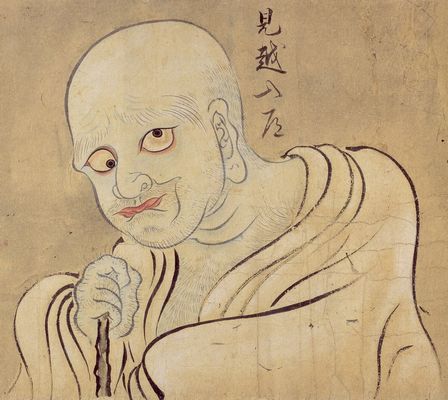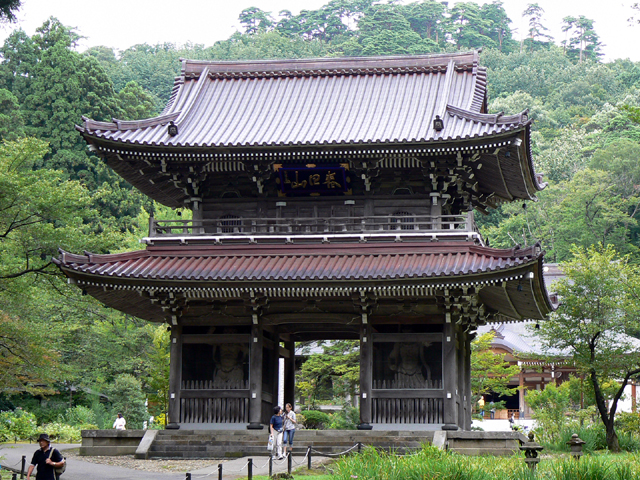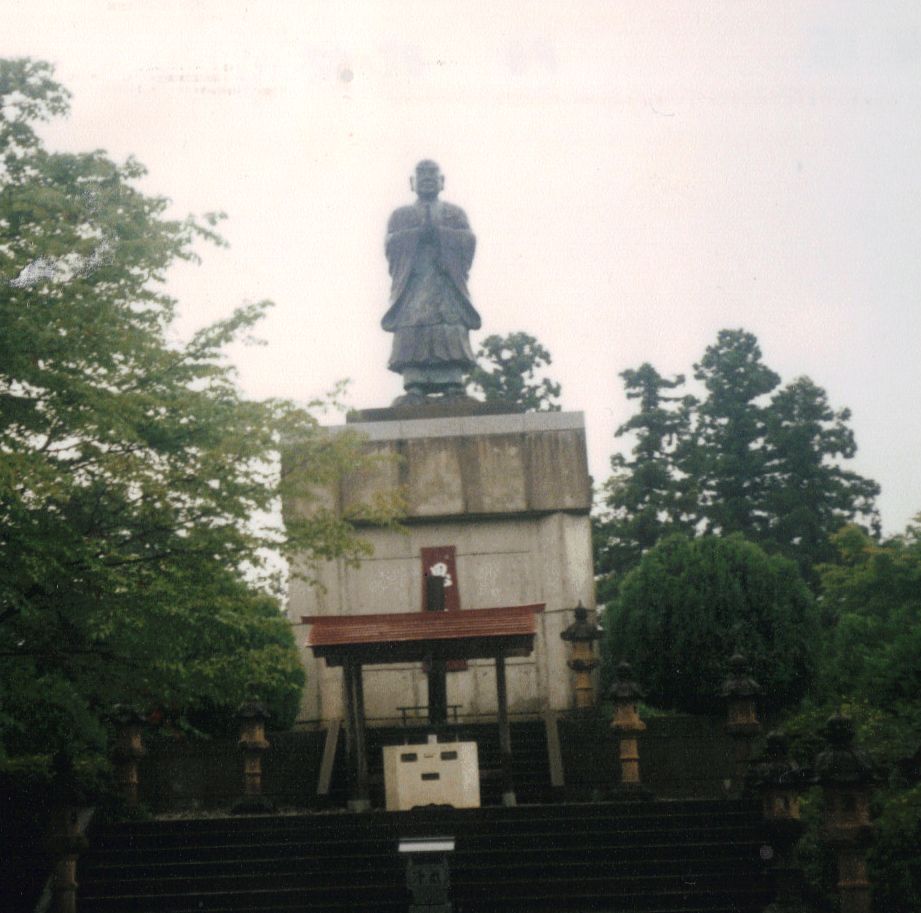|
Miage-nyūdō
Miage-nyūdō is a type of yōkai told about on Sado Island ( Sado, Niigata Prefecture). They are a type of mikoshi-nyūdō. Mythology When climbing a small slope at night, something taking on the appearance of a little bōzu would appear in front, and by looking up, it would become taller, and the person looking at it would fall down backwards. It is said that by chanting "" and lying down forwards, it would disappear. In Hamochi, Sado District (now a part of Sado), it is said that the miage-nyūdō that appears at a place called Tsujidō would steal food and money from travelers. In Utami, Ryōtsu (now a part of Sado), it is said that they are in places where trees grow thickly and is dim even at noon, and that a large stone called the "miage-ishi (見上石, look up stone)" has shapeshifted into a nyūdō. Once, a traveler met this, and by chanting "miage-nyūdō, I've seen past you" and striking it with a rod, the nyūdō disappeared. It is said that afterwards, when a jiz ... [...More Info...] [...Related Items...] OR: [Wikipedia] [Google] [Baidu] |
Mikoshi-nyūdō
''Mikoshi-nyūdō'' (見越し入道 or 見越入道) is a type of bald-headed ''yōkai'' "goblin" with an ever-extending neck. In Japanese folklore and Edo period (1603–1868) ''Kaidan (parapsychology), kaidan'' "ghost story" texts, ''mikoshi-nyūdō'' will frighten people who look over the top of things such as ''byōbu'' folding screens. The name combines ''mikoshi'' wikt:見越し, 見越し (lit. "see over") "looking over the top (of a fence); anticipation; expectation" and ''nyūdō'' wikt:入道, 入道 (lit. "enter the Way") "a (Buddhist) priest; a bonze; a tonsured monster". Summary When walking to the end of a road at night or a hill road, something the shape of a monk would suddenly appear, and if one looks up, it becomes taller the further one looks up. They are so big that one would look up at them, and thus are given the name "." Sometimes, if one just looks at them like that, one might die, but they can be made to disappear by saying "." They most frequently appe ... [...More Info...] [...Related Items...] OR: [Wikipedia] [Google] [Baidu] |
Sado Island
is an island located in the eastern part of the Sea of Japan, under the jurisdiction of Sado City, Niigata Prefecture, Japan, with a coastline of . In October 2017, Sado Island had a population of 55,212 people. Sado Island covers an area of , and is the second largest island after Okinawa Island outside of the four main islands of Japan, excluding the disputed Southern Kurils. The shortest distance between Sado Island and Honshu is . The highest peak on Sado Island is Mount Kinpoku, with an elevation of . Geography The shape of Sado Island resembles the kanji character for ‘work’ (工) in Japanese or the letter ‘S’. The topography of the island can be roughly divided into three parts, the Ōsado range in the north, the Kosado range in the south, and the Kakakura plain with flat terrain in between. The Ōsado range area is higher in altitude, and the highest peak of Sado Island, Mount Kinpoku ( above sea level), is also located in this area. The coastline on the n ... [...More Info...] [...Related Items...] OR: [Wikipedia] [Google] [Baidu] |
Sado, Niigata
is a city located on in Niigata Prefecture, Japan. Since 2004, the city has comprised the entire island, although not all of its total area is urbanized. Sado is the sixth largest island of Japan in area following the four main islands and Okinawa Island (excluding the Northern Territories). As of June 1, 2023, the city has an estimated population of 48,195 and a population density of . The total area is . History Political formation of the island The large number of pottery artifacts found near Ogi in the South of the island demonstrate that Sado was populated as early as the Jōmon period. The ''Nihon Shoki'' mentions that Mishihase people visited the island in 544 (although it is unknown whether Tungusic people effectively came). The island formed a distinct province, the Sado Province, separate from the Echigo province on Honshū, at the beginning of the 8th century. At first, the province was a single ''gun'' (district), but was later divided into three ''gun'': Saw ... [...More Info...] [...Related Items...] OR: [Wikipedia] [Google] [Baidu] |
Niigata Prefecture
is a Prefectures of Japan, prefecture in the Chūbu region of Honshu of Japan. Niigata Prefecture has a population of 2,131,009 (1 July 2023) and is the List of Japanese prefectures by area, fifth-largest prefecture of Japan by geographic area at . Niigata Prefecture borders Toyama Prefecture and Nagano Prefecture to the southwest, Gunma Prefecture to the south, Fukushima Prefecture to the east, and Yamagata Prefecture to the northeast. Niigata, Niigata, Niigata is the capital and largest city of Niigata Prefecture, with other major cities including Nagaoka, Niigata, Nagaoka, Jōetsu, Niigata, Jōetsu, and Sanjō, Niigata, Sanjō. Niigata Prefecture contains the Niigata Major Metropolitan Area centered on Niigata with a population of 1,395,612, the largest metropolitan area on the Sea of Japan coast and the twelfth-largest in Japan. Niigata Prefecture is part of the historic Hokuriku region and features Sado Island, the sixth largest island of Japan in area following the List o ... [...More Info...] [...Related Items...] OR: [Wikipedia] [Google] [Baidu] |
Hamochi, Niigata
is a city located on in Niigata Prefecture, Japan. Since 2004, the city has comprised the entire island, although not all of its total area is urbanized. Sado is the sixth largest island of Japan in area following the four main islands and Okinawa Island (excluding the Northern Territories). As of June 1, 2023, the city has an estimated population of 48,195 and a population density of . The total area is . History Political formation of the island The large number of pottery artifacts found near Ogi in the South of the island demonstrate that Sado was populated as early as the Jōmon period. The ''Nihon Shoki'' mentions that Mishihase people visited the island in 544 (although it is unknown whether Tungusic people effectively came). The island formed a distinct province, the Sado Province, separate from the Echigo province on Honshū, at the beginning of the 8th century. At first, the province was a single ''gun'' (district), but was later divided into three ''gun'': Sawat ... [...More Info...] [...Related Items...] OR: [Wikipedia] [Google] [Baidu] |
Ryōtsu, Niigata
was a city located in Sado Island, Niigata Prefecture, Japan. Population As of 2003, the city had an estimated population of 16,710 and a density of 71.60 persons per km2. The total area was 233.37 km2. History The city was founded on November 3, 1954. On March 1, 2004, Ryōtsu, along with the rest of Sado Island (the towns of Aikawa, Kanai, Sawata, Hatano, Mano, Hamochi and Ogi, and the villages of Niibo and Akadomari (all from Sado District)), was merged to create the city of Sado. Since then, Ryōtsu has been one of the 10 subdivisions of Sado City. Transportation Bus * Niigata Kotsu Sado Highway * Sea * Ryōtsu Port ** Sado Kisen Terminal *** Car ferry and Jetfoil services to/from Niigata Port Local attractions * Lake Kamo * Onogame * Futatsugame Kameiwa_Sado.jpg, Onogame 二ツ亀.jpg, Futatsugame Himezaki tohdai.jpg, Himezaki Lighthouse Climate See also *Sado, Niigata is a city located on in Niigata Prefecture, Japan. Since 2004, ... [...More Info...] [...Related Items...] OR: [Wikipedia] [Google] [Baidu] |
Akadomari, Niigata
is a city located on in Niigata Prefecture, Japan. Since 2004, the city has comprised the entire island, although not all of its total area is urbanized. Sado is the sixth largest island of Japan in area following the four main islands and Okinawa Island (excluding the Northern Territories). As of June 1, 2023, the city has an estimated population of 48,195 and a population density of . The total area is . History Political formation of the island The large number of pottery artifacts found near Ogi in the South of the island demonstrate that Sado was populated as early as the Jōmon period. The ''Nihon Shoki'' mentions that Mishihase people visited the island in 544 (although it is unknown whether Tungusic people effectively came). The island formed a distinct province, the Sado Province, separate from the Echigo province on Honshū, at the beginning of the 8th century. At first, the province was a single ''gun'' (district), but was later divided into three ''gun'': Sawat ... [...More Info...] [...Related Items...] OR: [Wikipedia] [Google] [Baidu] |



